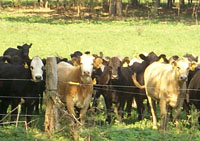Rotational Grazing of Alfalfa Can Improve Beef Profitability
Rotational Grazing of Alfalfa Can Improve Beef Profitability

Feed efficiency is the name of the game at the Berle Clay Farm in Bourbon County. Farm manager, Jason Sandefur, has found a great way to feed good quality forage, reduce fescue endophyte problems and stockpile fescue for winter feeding.
Rotational grazing on alfalfa provides a unique feed management system.
"Our grazing plan is to graze as many acres, with as many cattle, as we can and still provide the forage base for winter needs," Sandefur said. "Our basic strategy is to cut the high-yielding, high-quality forages as baleage the first cutting and then graze those same quality acres for the remainder of the season."
The system is working, the farm has increased its cattle inventory 30 percent, with plans to increase even more.
"Jason is addressing the issue of what forages to graze," said John Johns, beef specialist for the University of Kentucky College of Agriculture. "The standby is fescue of course, but we can do a better job with other forages and Jason is not afraid to try some of them."
The obvious problem with grazing alfalfa is bloat. He feeds a free-choice mineral containing 1620g/ton of Rumensin. He says it's important for cattle to consume about 150 mg Rumensin to adequately control bloat.
Berle Clay Farm runs four to five groups of 150 to 200 head of cattle in its rotations. They manage the cattle with an overall stocking rate of 1.25 acres per cow/calf pair and .75 acres for stocker cattle. This year, however, due to more normal rainfall, they needed about 50 to 60 percent more cattle at any given time. The cattle are in grazing rotations at a density of 10 to 25 head per acre.
Separated by high-tinsile electric fencing, fields range from 15 to 80 acres. Each of those fields is further divided into six to 20 acre paddocks by a single-strand of polywire and 3/8 fiberglass posts.
Sandefur moves the cattle every two to five days, depending on the size of the paddock and the amount of forage needing to be grazed in other areas. After cattle leave a paddock, it takes two to three weeks for the paddock to replenish.
"A good rule of thumb is to graze alfalfa about a week before you would cut it for hay," Sandefur said.
An additional management practice is to not turn cattle out onto new paddocks when alfalfa is wet with morning dew.
With tobacco on the decline, many farmers are looking for other ways to stay on the farm and still turn a profit. Johns said there is no reason why Kentucky can't step up and become more prominent beef producing state on the national level than it already is, ranking number eight in nation.
"All we have to do is look at Kentucky's natural resources to see the potential for the beef cattle industry here," Johns said. "We have great topography of land, weather and forage production. We have to have an industry that can capitalize on that ability to grow superior quality and quantity of forage, and I think the beef industry can do it."
Johns said the industry is changing. Video sales are becoming popular and now real time video streaming on the Internet is common in the purebred sales. Other areas of the beef industry, such as feeder cattle sales, also are looking that way.
The potential is there to make a good industry great. Kentucky cattle producers already know how to raise and market a quality product. Kentucky's existing beef marketing system can better serve producers by adapting new technologies as they emerge to show producers ways to increase the profitability of their herds.
